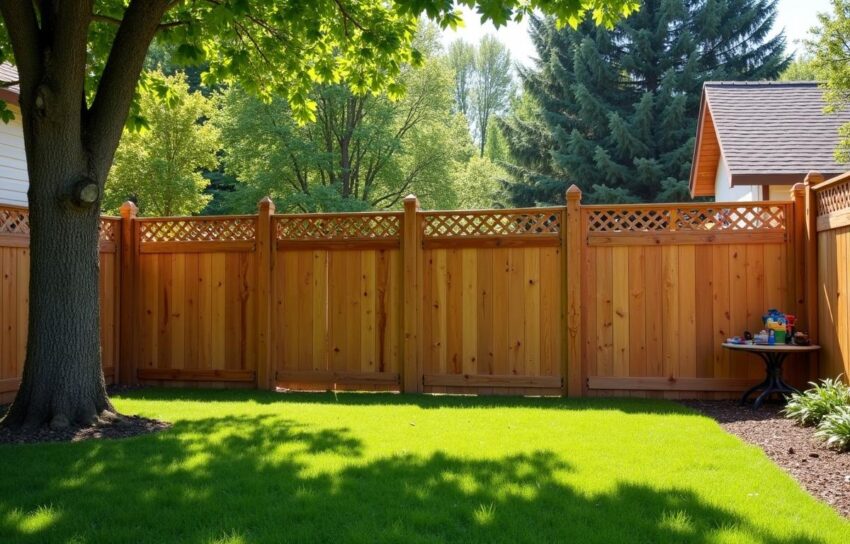Curious about the longevity of fences? Learn how long does a wood fence last in various conditions. That question crosses the minds of many homeowners when they’re planning yard upgrades. Some anticipate a beautiful perimeter that endures for years, while others worry about quick deterioration. It mostly comes down to wood quality, climate, and a few care habits. By choosing suitable materials and giving it enough attention, you can enjoy a sturdy fence that stands strong for a long time.
Contents
Estimating Wood Fence Lifespan
Wood fence lifespan hinges on several elements, with the type of wood being especially important. Cedar or redwood fences often last 15 to 20 years or more when consistently sealed and protected. Pine fences might clock in closer to 10 or 15 years, though they can endure longer with the right approach. Regular upkeep, from cleaning debris to checking posts, extends the fence’s service life. By investing in quality lumber, you lay the foundation for many seasons of stability.
You’ll find that small efforts keep the fence looking fresh. Routine painting or staining shields the boards from moisture and UV exposure. It also prevents warping, cracking, and insect invasion. Applying wood fence maintenance tips can add years to your fence and reduce costly repairs. A little proactive care often goes a long way toward preserving a flawless exterior.
Factors That Affect Durability
There are weighty factors affecting wood fence longevity, and wood species tops the list. Dense woods such as oak resist damage well but tend to be pricier. Softer woods like pine may need extra sealing and staining to stand up to harsh conditions. The environment you live in also plays a big role, because high humidity or frequent rainfall can speed up decay. By balancing cost, style, and durability, you can pick a wood type that suits your needs.
You should also consider types of wood for fences based on insect resistance. Termites pose a threat in warmer regions, so choosing cedar or treated lumber may save you trouble in the long run. Pressure-treated pine fences can hold up against bugs, but they still need occasional inspections. Budget and local conditions often guide these decisions. When you make the right match, your fence is more likely to last.
Exposure to Harsh Weather
Rain and snow wreak havoc on unprotected wood. The weather impact on wood fences becomes apparent when boards soak up water and expand. Later, they contract when things dry out, causing stress and potential cracks. High winds can loosen nails and screws, while direct sunlight can fade color prematurely. Sealing the fence and repairing minor damage promptly help it survive these challenges.
Maintenance Tips for Wood Fences
Maintenance tips for wood fences typically focus on preventing rot and stave off insects. Check for loose boards or splinters at least a couple of times a year. Apply protective stains or sealants every few years to reinforce the outer layer. Clean away dirt or algae buildup to keep the fence looking sharp. A little attention prevents bigger headaches down the road.
Some homeowners compare materials before settling on wood. They might consult a vinyl fence install guide if they prefer minimal upkeep and a more uniform appearance. Wood demands more regular maintenance but offers a classic charm that vinyl can’t replicate. By reviewing various options, you pinpoint what fits your vision best. Each material has different costs and care needs, so research helps you make an informed choice.
When it comes to budgets, reach out for a fence installation cost estimation to avoid surprises. You can also gather privacy fence pricing so you understand how high-grade options compare to simpler designs. Contractors often break down material costs, labor, and any additional fees. By collecting these details, you can plan a project that aligns with both your taste and wallet. Knowing what to expect can prevent unexpected setbacks.
Protecting Fence Posts
Fence posts often face the highest risk of moisture damage because they contact the ground directly. Installing them in concrete or gravel helps water drain away instead of pooling around the wood. This measure cuts down on rot and adds stability during intense weather. Sometimes, a wood fence longevity warranty covers certain issues if manufacturers feel confident about their product. Proper post installation ensures the fence stands upright for years to come.
Regular Checks Pay Off
It’s wise to inspect your fence regularly, even if everything seems fine. Look for small cracks, discolored spots, or rusted fasteners that could weaken the structure. Address these minor flaws early, and you’ll avoid more significant damage later. Tighten loose screws or replace broken boards to maintain the fence’s uniform look. By acting quickly, you protect your investment and keep the property looking well-kept.
Ultimately, the fence’s lifespan stems from your choice of materials, the surrounding climate, and how you care for each component. No matter how long a wood fence lasts in theory, your hands-on approach truly determines its endurance. Regular sealing, quick fixes, and sensible upgrades reduce the strain that harsh conditions impose. Whether you keep it purely functional or decorate it with flowers and vines, a wood fence remains a timeless feature for many homes. Consistent attention and a little know-how keep it standing solid for decades.
